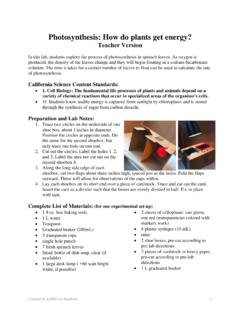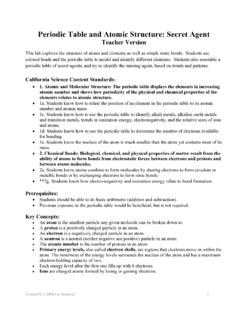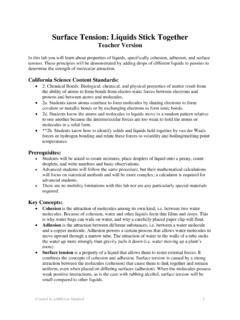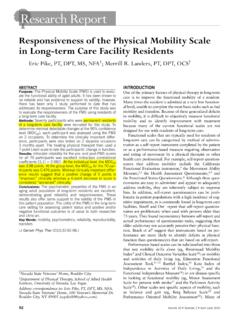Transcription of Nervous System: Reaction Time - Stanford University
1 Nervous system : Reaction time Teacher Version Preparation and Lab Notes: To set up the computer-based Reaction timer: 1. Unzip the archive 2. Open up a terminal window and go into the rxntimelab directory. 3. Type python . 4. Make sure the volume is turned up on the computer Prerequisites: Student Version: Students are expected to use a calculator to take averages and square roots. Student Advanced Version: Students are expected to know how to take averages and square roots and to use the formula distance = rate * time . One question in Part 3 requires knowledge of basic trigonometry. The advanced version includes more concept questions, some of which can be answered with names of specific nerves and muscles (eg: optic nerve ) by those studying anatomy, or can be answered more generically (eg: nerve connecting your eyes and your brain ) by others.
2 California Science Content Standards: 9. Physiology: As a result of the coordinated structures and functions of organ systems, the internal environment of the human body remains relatively stable (homeostatic) despite changes in the outside environment. 9b. Students know how the Nervous system mediates communication between different parts of the body and the body's interactions with the environment. **9c. Students know how feedback loops in the Nervous system [and endocrine]. system (s) regulate conditions in the body. **9d. Students know the functions of the Nervous system and the role of neurons in transmitting electrochemical impulses. **9e. Students know the roles of sensory neurons, interneurons, and motor neurons in sensation, thought, and response. Materials: 1 meter stick for every 2 students (or fewer if they work in larger groups).
3 Calculators (or the calculating function on students' cellular phones). Computers (running MacOS or Linux), with python installed and a working mouse Headphones recommended if using more than one computer at a time Penlight or small flashlight (1 or 2). Place where students can sit so that their legs dangle freely Piece of cardboard Created by LABScI at Stanford 1. Key Concepts: Your Nervous system allows your body to react to different stimuli (external events). reactions can be voluntary (eg: swinging a bat at a ball flying at you) or involuntary (eg: blinking at a puff of air). A reflex is a rapid, automatic response to a stimulus o examples: shivering if the temperature is too cold; moving your hand if it gets too close to a hot surface. Reflexes require at least two neurons, or nerve cells, to function.
4 Sensory neurons take in information (input) from the outside world, whereas motor neurons give information (output) to muscles and joints. Some reflexes are processed in the brain, while others are processed in the spinal cord The 5 steps of a typical reflex arc are: a. Arrival of stimulus and activation of a receptor b. Activation of sensory neuron c. Information processing by interneuron d. Activation of a motor neuron e. Response by an effector (the muscle that carries out the response). Introduction: Suppose a ball is thrown toward your head. You may react by catching the ball, by ducking, or by blinking and turning your head. In each case, you must sense the arrival of a signal ( the sight of the ball flying towards you), process this information and react to it. In this lab, you will explore how your Nervous system allows you to react to signals from the world around you.
5 You will measure your Reaction times to various visual and auditory stimuli and observe the effects of several variables on these Reaction times. You will also elicit and observe some innate reflexes. The lab consists of three stations, to be done in order. In the Ruler Station, you measure your Reaction time by catching a falling ruler. In the Computer Station, you will use an application that tracks your Reaction time to visual and auditory stimuli. In the Reflex Station, you will observe a couple of innate reflexes that are often used for diagnostic purposes. Each section contains questions for discussion. Part 1 Ruler Station Materials: Metric ruler, calculator Holding your thumb and index finger about 4 cm apart, catch the ruler when your partner drops it. Do 5 practice runs without recording the results.
6 Now record the results for 3 more trials of the experiment. Repeat the experiment holding your fingers 10 cm apart. Record your results in the chart below. Repeat the experiment saying every other letter of the alphabet while waiting for the ruler to drop. Record your results. Created by LABScI at Stanford 2. 4 cm 10 cm Alphabet (4 cm) Key Word (4 cm). Trial 1 cm cm cm cm Trial 2 cm cm cm cm Trial 3 cm cm cm cm Average length cm cm cm cm Reaction time sec sec sec sec To calculate the average length, use the formula length = (trial 1 + trial 2 + trial 3) 3. To calculate the Reaction time , use the formula: time = length / 490. (Note: this formula takes length in units of cm and gives time in units of seconds). (non-graphing calculator buttons: length, , 490, ). Typical Reaction times for the ruler experiment should be on the order of sec.
7 Q1. Is there a difference in the calculated Reaction time between the 4 cm and 10 cm inch trials? Which one seems to be faster? What could you learn from a series of experiments where the subjects' fingers start at different separations? The Reaction times will generally be slightly longer with the fingers starting 10cm rather than 4cm apart since it takes longer to move them by that distance. By doing a series of such experiments, you could get an estimate of the time required to react to the stimulus versus the time required to actually move the fingers together once the signal to grasp has been received. Q2. Did your Reaction time increase or decrease while you were saying the alphabet? Explain why you think this happens. Reaction should increase slightly due to the distraction. Now repeat the experiment with the following twist: only catch the ruler when your partner says the key word monkey.
8 Be sure to say the word before dropping the ruler. Your partner should try to trick you by occasionally dropping the ruler while saying other, incorrect, words. (For instance, if the experimenter says banana and then drops the ruler, don't catch it!). Keep trying until you catch the ruler 3 times in a row on the correct word WITHOUT any mistaken catches on the wrong word. Record the length at which the ruler was caught for those three times. Q3. Did your Reaction time increase or decrease? Explain why. In this case, the Reaction time includes not only the time required to process the auditory and visual stimuli, but the decision if it is correct or not (recognition time ). Thus, the overall Reaction will be slower. Created by LABScI at Stanford 3. Ruler station Concept Questions: QSA4.
9 Consider the 5 steps of a reflex arc (see Key Concepts ). What are the components of the neural system involved in each of the 5 steps for the specific case of the subject catching the ruler? (a.) visual stimulus activates photoreceptors (b.) the sensory optic nerve is activated (c.). information is processed in the midbrain (d.) the median nerve (a motor neuron) carries the signal to the hand (e.) muscles in the hand cause the fingertips to come together QSA5. You answered several questions asking if there was a difference between two runs of the experiment. Of course, no two measurements will ever come out identically the same. Explain how you would determine whether the difference between two runs of the experiment is significant (meaningful) or not? In addition to the average Reaction times, one should also get a measure of how much the times vary: the standard deviation.
10 If the difference between the Reaction times in two runs of the experiment is greater than a standard deviation or so then this is most likely due to a real underlying difference in the Reaction times rather than just variability in the experiment. Part 2 Computer Station Materials: Computer with functional speakers and a mouse Headphones for each computer, if multiple computers are used The Reaction timer should already be open on your laptop. Ask your teacher if you can't see it. Visual: Click on the Visual button near the top of the window. You should see two gray circles and a button labeled Start to the right of them. Click on the Start button. The top circle will turn red and the timer will wait for a few seconds. As soon as you see the red light on top switch to a green light on the bottom, click and release the button (now labeled End ).





